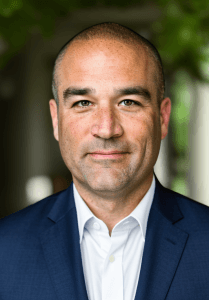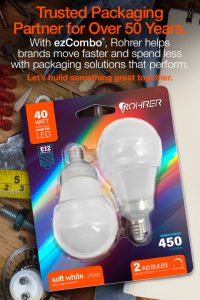Every organization claims “Great Customer Service.” Of course! Would you work with a vendor who said they’re going to treat you like junk? When you research a packaging manufacturer, look for concrete examples of customer service and added value. One of the best ways for procurement and supply chain experts to reduce costs is to remove the headaches and time associated with poor customer service.
Brian Gaffney, an applications engineer, and Rohrer’s heat seal supervisor started working within our engineering department in 2003.
He shares an office with our design team. Their easy collaboration fosters Brian’s ability to be proactive in designing heat seal tooling, and achieving our best-in-industry tooling timelines. He also works with Rohrer’s clients to troubleshoot or solve issues they have with their manufacturing process. Occasionally, he can identify and resolve issues with a review of a sample, but many times Brian makes the trip to our clients’ facilities.
One of our clients is a manufacturer of lighting and safety equipment primarily for first responders and tradespeople. They called for help with some new packaging, and Brian visited them. When Brian returned from his trip, I asked him to tell me about the project.
What kind of packaging does Rohrer produce for our client?
It’s a challenging package – first and foremost. It’s a trapped blister with some unique features. The package has overlapping “puzzle-piece flanges” so both pieces of plastic seal to the card. There are two blisters and two cards that we produce for each package.
Why did they ask you to get involved in this project?
They were having some sealing issues. There was a lack of seal – a lack of package security. When we first started designing this package, we went back and forth with them a lot, as far as what can be done, what can’t be done. We were pushing the limits on how this package was to seal. They were aware of it and were skating by, but when they changed the card, things weren’t working.
I got pulled in about halfway through the process because they said they were having some trouble sealing. The team in our paperboard facility pulled some samples that were sealing fine, and then it was brought into my arena. I scheduled a meeting with them, but worked on some troubleshooting in the meantime.
I started by making a test fixture to seal up on our equipment, and I asked them to send me exactly the blisters and cards they were using so I could use them on my machine. That allowed me to compare apples-to-apples, and try to uncover what was going on. I tried to replicate the issues they were having. And I did. I was able to replicate some of the sealing issues but I was able to make adjustments on our machine to be able to get it to a level of acceptability of seal.
Did you share your findings with our partner?
I figured it out the day before I was scheduled to go, and I went ahead and made the trip. They were very happy to see [their Account Executive and me]. And I told them I was there until we got it fixed. I didn’t have a return flight scheduled. I said, “I’m here until we get it done.”
We went through 8-10 different packages and addressed each one individually. Each one required slight adjustments because the packaging was new. I held their hands through some natural troubleshooting, so next time they have something new, they know what to do.
How did you help prepare them for troubleshooting future projects?
As I was making adjustments and trying things out, I was basically providing them a blueprint to troubleshoot for the future.
What’s on a heat seal packaging troubleshooting blueprint?
That’s hard – customers have asked that before – but it would really be an extremely long list. I could summarize it in three main chapters: I help our partners work through auto-feeding, heat sealing, and productivity or ‘through-put”.
What influences your decision to go on-site with a client versus working with their sample?
It’s a case-by-case basis. Certainly, the complexity of the issue or size of our partnership comes into play.
Usually when I’m entering the situation, it’s not one “big bad thing” that’s causing the trouble, it’s many different things feeding into the same issue. That’s why I like to visit whenever possible.
One of my main objectives when going to any customer is trying to find the window of acceptability and making it as large as possible. This is really helpful in manufacturing. There’s all these different factors that contribute or hurt a situation – changes in the weather, humidity… So if we make that window as big and forgiving as possible, our clients won’t have to do anything special with settings or materials.
Unless it’s for a specific long-term project, 90% of the trips I take, we don’t charge our clients. For example, I’m going to spend a few days working with one of our partners to set up their new systems, but that’s different. I’ve visited another client of ours more than a dozen times over the years and that’s been added value for our partnership, just to facilitate the quality.
What were the results of your intervention?
We evaluated the majority of the client’s newer SKU’s one-by-one. I showed them step-by-step what to do, how to troubleshoot it right now, and how to troubleshoot it in the future. I provided recommended solutions including the possibility of changes in their design or sealing rubber. It’s actually something I recommended before but they nixed. Now they want to do it. I’m in the process of showing them designs which they will have made. In this case, I even recommended a different type of machine.
These are the steps they can take and we can take with them to keep things going in a positive direction.
Do you think the services you provide are in anyway related to time-to-market for our customers?
Absolutely! It ties into the fact that one of the main reasons that I am here in the design office.
With almost everything we do, we’re trying to push the limits of space requirements or automation requirements. When a project is brought in here and comes across Mark’s desk [the Design Manager], if there are any alarms or red flags, I am sitting right here and we can discuss them. All the designers are very knowledgeable and they can spot some of these issues. But when they come up we can discuss them immediately as opposed to having it get past design and customer review and finding problems in manufacturing. This collaboration definitely contributes to speed-to-market because we address problems before they become problems.
Does the proactive approach to potential problems help our clients reduce costs?
Definitely. Now, if they have problems with a new package, they may have to manipulate it manually. They might have to add an extra person on the line just to make things work, or handling instead of auto-fed. There’s more cost.
Our heat seal tooling program has a 12 working-day lead time for tooling – that’s the best in the industry, and we’ve been doing it for a while. We match up our blisters with our tooling. Other packaging manufacturers may try to push to get closer to our lead time, but they haven’t been able to. They might farm out the heat seal tooling or do it in-house but not as quickly or effectively. One of the reason our clients come back to us is our responsiveness. Engineers say when they have the choice they come to us. They like us because of our quality and lead time.
And of course, our great customer service.
Looking for ways to get more from your packaging partner? Try getting in touch with one of our experts!



